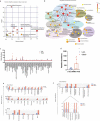Obesity enriches for tumor protective microbial metabolites and treatment refractory cells to confer therapy resistance in PDAC
- PMID: 35816618
- PMCID: PMC9275504
- DOI: 10.1080/19490976.2022.2096328
Obesity enriches for tumor protective microbial metabolites and treatment refractory cells to confer therapy resistance in PDAC
Abstract
Obesity causes chronic inflammation and changes in gut microbiome. However, how this contributes to poor survival and therapy resistance in patients with pancreatic cancer remain undetermined. Our current study shows that high fat diet-fed obese pancreatic tumor bearing mice do not respond to standard of care therapy with gemcitabine and paclitaxel when compared to corresponding control diet-fed mice. C57BL6 mice were put on control and high fat diet for 1 month following with pancreatic tumors were implanted in both groups. Microbiome of lean (control) and obese (high fat diet fed) mice was analyzed. Fecal matter transplant from control mice to obese mice sensitized tumors to chemotherapy and demonstrated extensive cell death. Analysis of gut microbiome showed an enrichment of queuosine (Q) producing bacteria in obese mice and an enrichment of S-adenosyl methionine (SAM) producing bacteria in control diet-fed mice. Further, supplementation of obese animals with SAM sensitized pancreatic tumors to chemotherapy. Treatment of pancreatic cancer cells with Q increased PRDX1 involved in oxidative stress protection. In parallel, tumors in obese mice showed increase in CD133+ treatment refractory tumor populations compared to control animals. These observations indicated that microbial metabolite Q accumulation in high fat diet-fed mice protected tumors from chemotherapy induced oxidative stress by upregulating PRDX1. This protection could be reversed by treatment with SAM. We conclude that relative concentration of SAM and queuosine in fecal samples of pancreatic cancer patients can be developed as a potential biomarker and therapeutic target in chemotherapy refractory pancreatic cancer.
Keywords: Pancreatic cancer; chemoresistance; gut microbiome; obesity; queuosine S-adenosyl methionine.
Conflict of interest statement
University of Minnesota has a patent for Minnelide, which has been licensed to Minneamrita Therapeutics, LLC. SB was a consultant with Minneamrita Therapeutics LLC and this relationship is managed by University of Miami. The remaining authors declare no conflict of interest.
Figures







Similar articles
-
Dietary fat and gut microbiota interactions determine diet-induced obesity in mice.Mol Metab. 2016 Oct 13;5(12):1162-1174. doi: 10.1016/j.molmet.2016.10.001. eCollection 2016 Dec. Mol Metab. 2016. PMID: 27900259 Free PMC article.
-
High-Fat Diet Accelerates Carcinogenesis in a Mouse Model of Barrett's Esophagus via Interleukin 8 and Alterations to the Gut Microbiome.Gastroenterology. 2019 Aug;157(2):492-506.e2. doi: 10.1053/j.gastro.2019.04.013. Epub 2019 Apr 15. Gastroenterology. 2019. PMID: 30998992 Free PMC article.
-
Methionine Restriction Regulates Cognitive Function in High-Fat Diet-Fed Mice: Roles of Diurnal Rhythms of SCFAs Producing- and Inflammation-Related Microbes.Mol Nutr Food Res. 2020 Sep;64(17):e2000190. doi: 10.1002/mnfr.202000190. Epub 2020 Aug 9. Mol Nutr Food Res. 2020. PMID: 32729963
-
High fat diet, gut microbiome and gastrointestinal cancer.Theranostics. 2021 Apr 3;11(12):5889-5910. doi: 10.7150/thno.56157. eCollection 2021. Theranostics. 2021. PMID: 33897888 Free PMC article. Review.
-
Intratumour microbiome of pancreatic cancer.World J Gastrointest Oncol. 2023 May 15;15(5):713-730. doi: 10.4251/wjgo.v15.i5.713. World J Gastrointest Oncol. 2023. PMID: 37275446 Free PMC article. Review.
Cited by
-
The Microbiome in PDAC-Vantage Point for Future Therapies?Cancers (Basel). 2022 Dec 2;14(23):5974. doi: 10.3390/cancers14235974. Cancers (Basel). 2022. PMID: 36497456 Free PMC article. Review.
-
Intestinal Flora in Chemotherapy Resistance of Biliary Pancreatic Cancer.Biology (Basel). 2023 Aug 21;12(8):1151. doi: 10.3390/biology12081151. Biology (Basel). 2023. PMID: 37627035 Free PMC article. Review.
-
Microbiome and pancreatic cancer: time to think about chemotherapy.Gut Microbes. 2024 Jan-Dec;16(1):2374596. doi: 10.1080/19490976.2024.2374596. Epub 2024 Jul 18. Gut Microbes. 2024. PMID: 39024520 Free PMC article. Review.
-
Biosynthesis and function of 7-deazaguanine derivatives in bacteria and phages.Microbiol Mol Biol Rev. 2024 Mar 27;88(1):e0019923. doi: 10.1128/mmbr.00199-23. Epub 2024 Feb 29. Microbiol Mol Biol Rev. 2024. PMID: 38421302 Free PMC article. Review.
-
A comprehensive multi-omics analysis uncovers the associations between gut microbiota and pancreatic cancer.Front Microbiol. 2025 May 1;16:1592549. doi: 10.3389/fmicb.2025.1592549. eCollection 2025. Front Microbiol. 2025. PMID: 40376462 Free PMC article.
References
-
- Genkinger JM, Spiegelman D, Anderson KE, Bernstein L, van den Brandt PA, Calle EE, English DR, Folsom AR, Freudenheim JL, Fuchs CS, et al. A pooled analysis of 14 cohort studies of anthropometric factors and pancreatic cancer risk. Int J Cancer. 2011;129:1708–1717. doi:10.1002/ijc.25794. - DOI - PMC - PubMed
Publication types
MeSH terms
Substances
Grants and funding
LinkOut - more resources
Full Text Sources
Other Literature Sources
Medical
Research Materials
Miscellaneous
